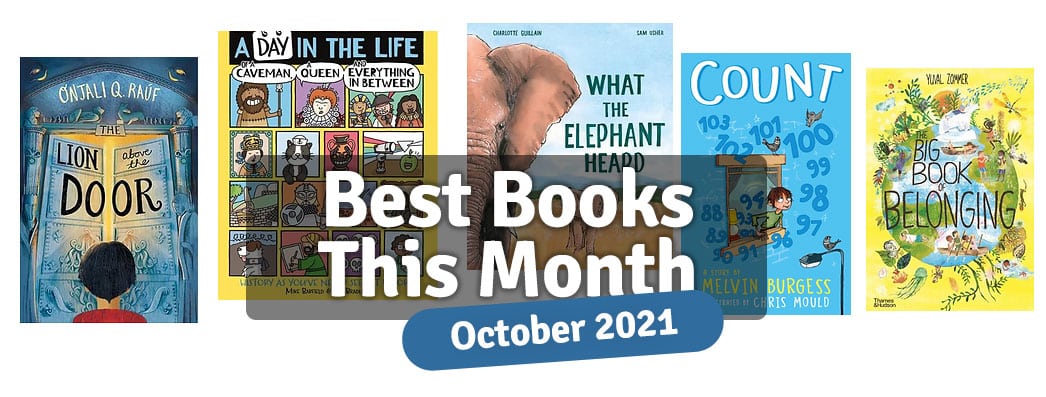It’s easy to feel lost in the flood of so many new children’s books available. Each month, we pick five of our recently published favourites.
Check out our Review Panel’s top picks for you to read in October 2021…


It’s easy to feel lost in the flood of so many new children’s books available. Each month, we pick five of our recently published favourites.
Check out our Review Panel’s top picks for you to read in October 2021…
This colourful, cartoon-style reference book brings history to life with humour and fun. Following on from the enormous success of its award-winning predecessor ‘A Day in the Life of a Poo, a Gnu and You‘, this book is packed full of information and facts, presented in an entertaining comic style that is a joy to read.
The book is divided into three main sections – Ancient History, The Middle Ages, and The Modern Age. Within each section, relevant ‘day in the life’ comics describes certain aspects of history. We learn about the typical day of a Neanderthal, an Inca Farmer, and a Gladiator, as well as the more unexpected daily routines of a wheel, a Samurai sword, and a stick of chalk!
Additional ‘bigger picture’ pages give extra details and more in-depth information – for example on Civil Rights, the Terracotta Army, and the world map. ‘Secret Diaries’ provides a wider viewpoint over a larger timescale – we find out from Isaac Newton’s cat that he got stuck in an apple tree, dislodging one of the fruits; The diary of a wooden board from Leonardo da Vinci’s studio stretches over four hundred years and sees the board end up in an art gallery in Paris. ‘Newsflashes’ are interspersed throughout the book and give more context to the ‘days in the life’ and ‘secret diaries’ by filling you in on what else was happening in the world at the time, and there is also a world map and a glossary for easy reference.
Readers will enjoy the variety of historical information, which feels like a balanced view of different areas of the globe. This is a great book to sit and read individually, or to dip into when exploring related topics.
Anyone who has ever wanted the world to recognise their talent or dreamed of going viral will resonate with Brandon’s story. Brandon believes that he is the best at everything and he loves to boast about it. But there is one thing that he really is good at – counting. When he boasts that he can count to ten million, he’s challenged to follow up on his claim and before he knows it, the world really is paying attention to what he can do.
Carnegie-medal winner Melvin Burgess is well-known for his novels for Young Adults, but here he perfectly hits the spot for younger children with Count. I was really charmed by this laugh-out-loud story of an oft-heard playground boast that – in this case – quickly snowballs to global proportions, perfectly capturing the essence of childhood ambition and stubbornness in one sweep. The story also explores the cost of fame and the power of self-belief.
At just over 170 pages, this is a short and entertaining read that is packed with humour and accompanied by Chris Mould’s fun illustrations. Count is likely to go down a treat in lower KS2 classrooms or with Upper KS2 readers who appreciate a quick and humorous read.
This is a beautiful picture book that follows a herd of African elephants as they journey to find water in the African savannah.
The Matriarch leads the herd and tells of times gone by and stories of how the landscape used to be. Soon, the story moves on to the invasion of humans and how they drove some of the other animals away from their natural habitat by building, making loud noises and causing destruction of the landscape.
The threat from poachers forces the herd to move on, still searching for the elusive water. As the situation looks bleak for the herd, Grandma Elephant smells that familiar smell that she was taught to look for when she was a calf and the elephants arrive at the watering hole.
Told in gentle rhyming couplets and accompanied by wonderful illustrations, this is a heartfelt story told in a way to help young children understand some of the challenges faced by Africa’s majestic giants.
Accompanying the story, readers can delve into a fantastic non-fiction section at the back of the book. A non-chronological report, information about how to care for elephants and the work of wildlife rangers, and messages about conservation efforts allow the reader a greater understanding of the plight of these animals. Readers are also encouraged to be a local wildlife hero.
This book will be great to use in a primary schools. The range of mini texts types gives a rounded approach to the topic and offers superb model texts to use in the classroom. The stunning illustrations will be ideal for initiating discussion and deeper thinking around the themes explored. The book also links to topics of conservation, habitats and animal survival. I can’t wait to share this with my class.
Fans of Yuval Zommer’s Big Book series may have been guessing which alliterative topic was next to come after poring over the previous Big Book of the Blue, The Big Book of Birds, the Big Book of Bugs and the Big Book of Beasts. I wonder how many – if any – correctly landed on ‘Belonging’ as the theme of the latest large-format hardback in this much-loved collection.
The Big Book of Belonging aims to unite young readers from around the globe under one banner – of belonging to planet Earth. In his foreword, the author says, “The Big Book of Belonging is my way of celebrating the wondrous connections between us humans and the natural world. From the air that we breathe, the food we eat, the adventures we seek, to the joy we experience, you will find a connection to nature in every single part of our being. And the more we can reconnect with nature, the more we can reconnect with ourselves.”
Illustrated in full colour in Yuval Zommer’s iconic style, the book is packed with natural history facts that draw out just how much a part of the natural world humans are. Readers may be surprised to discover that sea otters hold hands just like humans do, or that scientists believe that listening to bird song can boost the hormones in our bodies that help us to concentrate and focus better, and that butterflies also have bedtimes. They’ll learn that just as humans have unique fingerprints, zebras have different stripes, cowrie shells have distinct spots and that no two snowflakes are identical.
As well as a host of interesting facts, readers will come across a range of familiar knowledge too – like how leaves fall from trees in Autumn or how frogs start life as frogspawn. Each page of facts is presented as part of a connection between humans and nature – the leaves fall off trees just as human hair falls out when we brush it or male fallow deer shed and regrow their antlers every year.
The book’s uplifting tone, super-short snippets of facts and full colour illustrations make it suitable for younger children looking to collect information without becoming overhwhelmed as well as for older children looking to dive into the connections between the facts they know. This is a lovely book for sharing and discussing, making it a highly suitable choice for primary classrooms.
Onjali Q Rauf’s loyal fanbase will be pleased to hear of a new novel. True to form, the Lion Above the Door explores important social issues while capturing voices from the younger generation in a most relatable manner.
The story broaches the topic of cultural blindspots in history education, posing questions about the missing and ignored figures from the history topics taught in schools. Young Leo is intrigued to find a WW2 memorial in which he recognises his own name; being of Singaporean heritage he has become used to rarely seeing people like himself reflected in the history books. As Leo and his classmates research their relatives’ roles in the war, important stories come to the surface and it’s up to the children to make sure these histories get the spotlight they deserve.
This is a sincere and timely story that gently turns over themes of prejudice, cultural underrepresentation, racism and the courage to put right societal injustice – while at once holding out the mantle to young readers to invite them to be the catalyst for change.

Reviewers: Alison Leach, Marion Park, Amy Cross-Menzies

© BooksForTopics 2015-2024
review
Year group(s) the book is most suitable for:
Year group(s) the book is most suitable for:
Does the book contain anything that teachers would wish to know about before recommending in class (strong language, sensitive topics etc.)?
Does the book contain anything that teachers would wish to know about before recommending in class (strong language, sensitive topics etc.)?
Would you recommend the book for use in primary schools?
yes
Curriculum links (if relevant)
Curriculum links (if relevant)
Any other comments
Any other comments